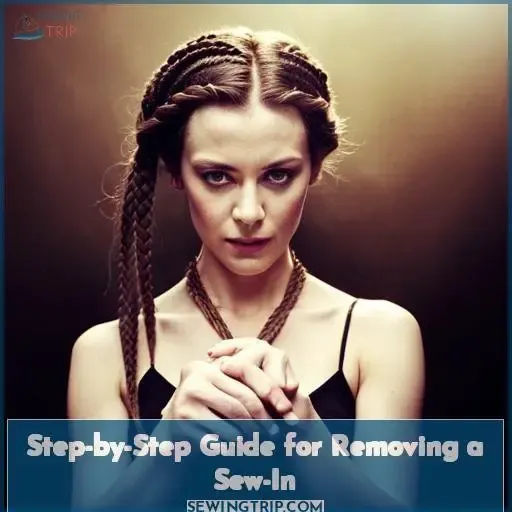This site is supported by our readers. We may earn a commission, at no cost to you, if you purchase through links.
 Ready to free yourself from your sew-in? Say goodbye to the added length and volume with this step-by-step guide on how to remove a sew-in.
Ready to free yourself from your sew-in? Say goodbye to the added length and volume with this step-by-step guide on how to remove a sew-in.
From gathering the necessary tools and supplies, detangling and removing the wefts, to taking care of your natural hair afterwards – we’ve got you covered.
Table Of Contents
- Key Takeaways
- Tools and Supplies Needed for Removing a Sew-In
- Step-by-Step Guide for Removing a Sew-In
- Tips and Tricks for a Smooth Removal Process
- What to Do if You Encounter Challenges or Difficulties
- Aftercare and Maintenance for Your Natural Hair
- Reusing or Storing Your Extensions for Future Use
- Frequently Asked Questions (FAQs)
- Conclusion
Key Takeaways
- Prepare the necessary tools and supplies such as scissors, paddle brush, alligator clips, and a mirror.
- Follow a step-by-step guide for safe and effective removal, including gentle thread or elastic band removal, detangling, and caring for natural hair.
- Use tips and tricks for a smooth removal process, such as using a seam ripper, being gentle, and sectioning out the wefts.
- Overcome challenges or difficulties by using detangling conditioner, scissors for stubborn wefts, and misting hair with water or oil for tight braids.
Tools and Supplies Needed for Removing a Sew-In
To remove a sew-in, you’ll need basic tools such as:
- Scissors
- A paddle brush
- Alligator clips
- A mirror
Additionally, gather:
- Cleanser for your natural hair
- Detangling conditioner
These essential hair tools will assist in safely removing your sew-in extensions without causing damage to your natural strands.
The scissors are used to carefully cut the thread or elastic band that holds the wefts in place.
The paddle brush helps detangle any knots or tangles before beginning the removal process.
Alligator clips can be used to secure sections of hair while working on other areas.
Lastly, having a mirror allows you to see what you’re doing from different angles for better precision during weave removal.
Step-by-Step Guide for Removing a Sew-In
Now that you have gathered your supplies and are ready to remove your sew-in, let’s discuss the step-by-step guide.
First, focus on removing the thread or elastic band by carefully sliding scissors underneath and snipping it away.
Next, detangle and remove the wefts by unbraiding your hair in sections and using a paddle brush to gently brush from ends to roots.
Finally, don’t forget to take care of your natural hair by cleansing with a sulfate-free shampoo and deep conditioning treatment before reusing or storing your extensions properly.
Removing the Thread or Elastic Band
To start removing your sew-in, carefully remove the thread or elastic band that’s holding the extensions in place.
Use a gentle unweaving process and detangling techniques to ensure minimal damage to your natural hair.
Follow this step-by-step guide for a smooth removal process.
Detangling and Removing the Wefts
Now that you have successfully removed the thread or elastic band, it’s time to detangle and remove the wefts from your sew-in.
Use gentle detangling techniques to prevent damage and ensure extension maintenance.
Style your natural hair after removal for a fresh look.
Taking Care of Your Natural Hair
First, gently detangle and care for your natural hair to ensure a smooth removal process.
Use a paddle brush and detangling conditioner to remove any knots or tangles.
Take the time to properly cleanse and moisturize your hair for optimal health and maintenance.
Tips and Tricks for a Smooth Removal Process
To ensure a smooth removal process for your sew-in weave, it’s important to follow these tips and tricks:
- Preventing Damage:
- Use a seam ripper instead of scissors to minimize the risk of cutting your natural hair while removing the securing stitches.
- Be gentle and take your time to avoid any unnecessary pulling or tugging.
- Aftercare Tips:
- Detangle and cleanse your natural hair thoroughly after removing the sew-in.
- Use a detangling conditioner and deep conditioner to restore moisture and nourishment.
- Quick Removal:
- Section out the wefts before starting, so you can easily locate them during the removal process.
By following these tips, you can remove your sew-in weave without causing damage or compromising the health of your natural hair. Remember to be patient, take breaks if needed, and prioritize proper aftercare for healthy-looking locks once removed.
What to Do if You Encounter Challenges or Difficulties
If you encounter challenges or difficulties while removing your sew-in, don’t panic. It’s common to face some issues during the process, but with the right troubleshooting tips and solutions, you can overcome them easily.
Here are some common problems that may arise and how to handle them:
| Challenges | Solutions | Troubleshooting Tips |
|---|---|---|
| Tangled Hair | Use a detangling conditioner | Gently brush from ends to roots in sections |
| Stubborn Wefts | Slide scissors underneath thread Slowly snip until loose | |
| Tight Braids | Mist hair with water or oil for added slip Gradually loosen braids |
By following these steps and employing these techniques, you’ll be able to navigate any difficulties that come your way while removing your sew-in. Remember to take it slow and be gentle with your natural hair as you work through the process.
Aftercare and Maintenance for Your Natural Hair
After removing your sew-in, it’s important to consistently and gently care for your natural hair.
Start by detangling your hair in sections using a paddle brush or wide-tooth comb, working from ends to roots.
Use a gentle cleanser specifically designed for natural hair to cleanse your scalp and strands thoroughly.
Follow up with a nourishing conditioner that will help moisturize and strengthen the hair. Deep conditioning treatments are also beneficial in restoring moisture and promoting overall health of the natural tresses.
Proper aftercare involves storing any reusable extensions properly by washing, conditioning, and laying them flat to dry before storage.
Remember that maintenance is key when it comes to keeping your natural hair looking its best!
Reusing or Storing Your Extensions for Future Use
To ensure the longevity of your extensions, properly caring for and storing them is essential.
After removing your sew-in weave, it’s important to follow some aftercare advice and maintenance guidelines to keep your extensions in good condition for future use.
First, remove any leftover thread or elastic band from the wefts using small scissors.
Gently detangle and brush through the hair to remove any knots or tangles.
Then, wash and condition the extensions with sulfate-free products before laying them flat to dry completely.
Once dry, store them in a safe place where they won’t get tangled or damaged until you’re ready to reuse them again.
Proper extension storage is key in maintaining their quality over time.
Frequently Asked Questions (FAQs)
Can I remove a sew-in weave without cutting the thread?
Yes, you can remove a sew-in weave without cutting the thread.
Carefully loosen the securing stitches with a tail comb and gently snip through the securing stitch to detach the weft.
How often should I remove and reinstall my sew-in weave?
When it comes to removing and reinstalling your sew-in weave, the key is balance.
Like a wise old adage says,
With great power comes great responsibility.
Find the sweet spot that keeps your hair healthy and fabulous.
Is it necessary to wash my hair before removing the sew-in weave?
Before removing your sew-in weave, it’s recommended to wash your hair. This helps remove any buildup or residue that may have accumulated over time. Clean and fresh hair ensures a smoother removal process and promotes healthier scalp conditions.
Can I reuse the same sew-in weave after removing it?
Absolutely, darling!
Once you’ve removed your sew-in weave, you can reuse it if it’s in good condition.
Just wash, condition, and detangle the extensions before laying them flat to dry.
Rock that fabulous hair again!
What should I do if I accidentally cut my natural hair while removing the sew-in weave?
If you accidentally snip your natural hair while removing a sew-in weave, don’t panic! Treat it like a precious gem in the rough.
Conclusion
To achieve a seamless removal of your sew-in, follow this step-by-step guide on how to remove a sew-in.
Gather the necessary tools and supplies, such as scissors and a detangling brush, to make the process smoother.
Start by removing the thread or elastic band, then detangle and remove the wefts carefully.
Take care of your natural hair afterwards with moisturizing products and gentle handling.
If you encounter any challenges, consult a professional for assistance.
Remember to maintain and care for your natural hair post-removal.












